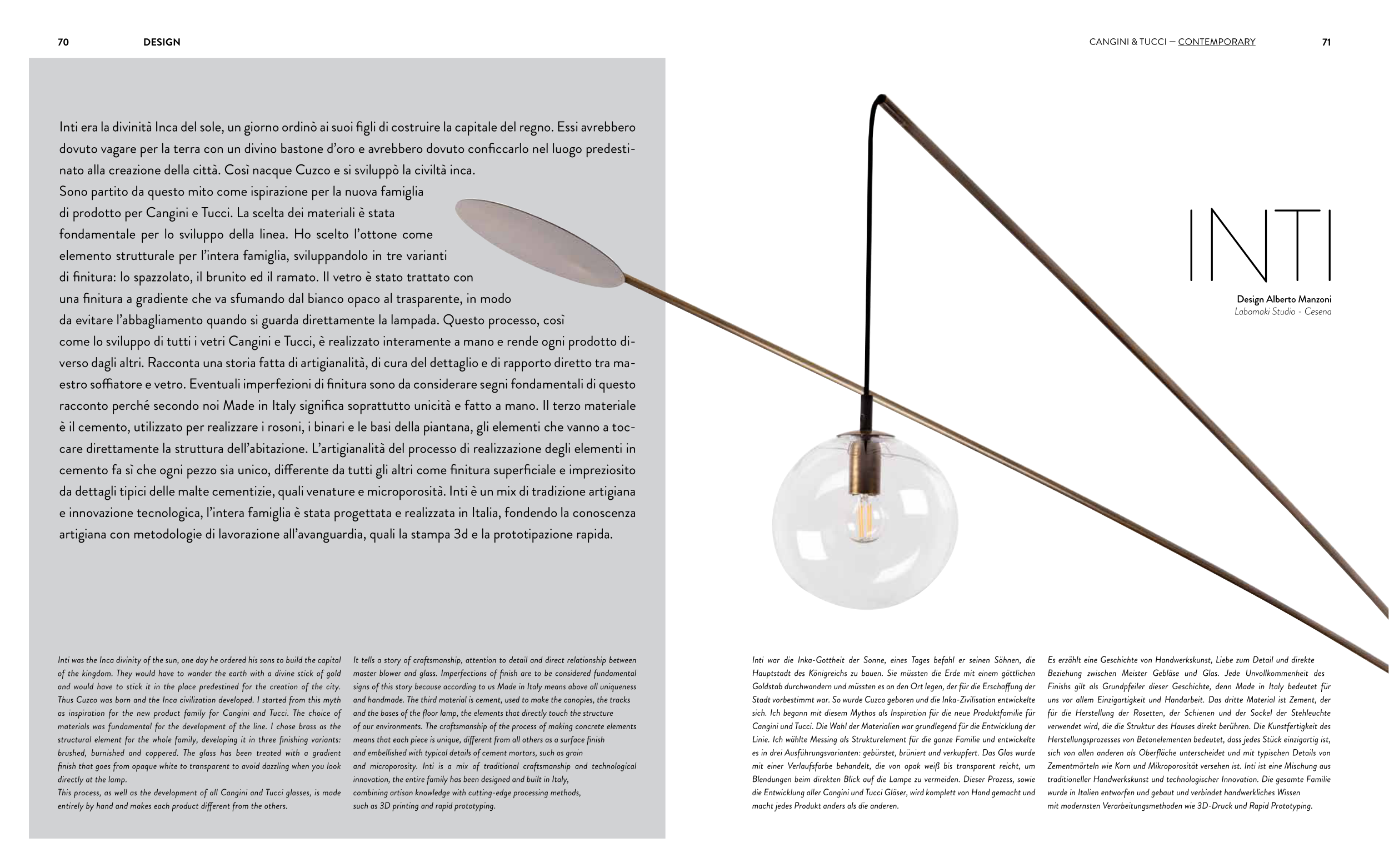inti was the inca divinity of the sun, one day he ordered his sons to build the capital
of the kingdom. they would have to wander the earth with a divine stick of gold
and would have to stick it in the place predestined for the creation of the city.
thus cuzco was born and the inca civilization developed. i started from this myth
as inspiration for the new product family for cangini and tucci. the choice of
materials was fundamental for the development of the line. i chose brass as the
structural element for the whole family, developing it in three finishing variants:
brushed, burnished and coppered. the glass has been treated with a gradient
finish that goes from opaque white to transparent to avoid dazzling when you look
directly at the lamp.
this process, as well as the development of all cangini and tucci glasses, is made
entirely by hand and makes each product different from the others.
it tells a story of craftsmanship, attention to detail and direct relationship between
master blower and glass. imperfections of finish are to be considered fundamental
signs of this story because according to us made in italy means above all uniqueness
and handmade. the third material is cement, used to make the canopies, the tracks
and the bases of the floor lamp, the elements that directly touch the structure
of our environments. the craftsmanship of the process of making concrete elements
means that each piece is unique, different from all others as a surface finish
and embellished with typical details of cement mortars, such as grain
and microporosity. inti is a mix of traditional craftsmanship and technological
innovation, the entire family has been designed and built in italy,
combining artisan knowledge with cutting-edge processing methods,
such as 3d printing and rapid prototyping.
inti war die inka-gottheit der sonne, eines tages befahl er seinen söhnen, die
hauptstadt des Königreichs zu bauen. sie müssten die erde mit einem göttlichen
goldstab durchwandern und müssten es an den ort legen, der für die erschaffung der
stadt vorbestimmt war. so wurde cuzco geboren und die inka-Zivilisation entwickelte
sich. ich begann mit diesem mythos als inspiration für die neue produktfamilie für
cangini und tucci. die wahl der materialien war grundlegend für die entwicklung der
linie. ich wählte messing als strukturelement für die ganze familie und entwickelte
es in drei Ausführungsvarianten: gebürstet, brüniert und verkupfert. das glas wurde
mit einer verlaufsfarbe behandelt, die von opak weiß bis transparent reicht, um
Blendungen beim direkten Blick auf die lampe zu vermeiden. dieser prozess, sowie
die entwicklung aller cangini und tucci gläser, wird komplett von hand gemacht und
macht jedes produkt anders als die anderen.
es erzählt eine geschichte von handwerkskunst, liebe zum detail und direkte
Beziehung zwischen meister gebläse und glas. jede unvollkommenheit des
finishs gilt als grundpfeiler dieser geschichte, denn made in italy bedeutet für
uns vor allem einzigartigkeit und handarbeit. das dritte material ist Zement, der
für die herstellung der rosetten, der schienen und der sockel der stehleuchte
verwendet wird, die die struktur des hauses direkt berühren. die Kunstfertigkeit des
herstellungsprozesses von Betonelementen bedeutet, dass jedes stück einzigartig ist,
sich von allen anderen als oberfläche unterscheidet und mit typischen details von
Zementmörteln wie Korn und mikroporosität versehen ist. inti ist eine mischung aus
traditioneller handwerkskunst und technologischer innovation. die gesamte familie
wurde in italien entworfen und gebaut und verbindet handwerkliches wissen
mit modernsten verarbeitungsmethoden wie 3d-druck und rapid prototyping.
inti
design alberto Manzoni
labomaki Studio - cesena
Inti era la divinità Inca del sole, un giorno ordinò ai suoi figli di costruire la capitale del regno. Essi avrebbero
dovuto vagare per la terra con un divino bastone d’oro e avrebbero dovuto conficcarlo nel luogo predesti-
nato alla creazione della città. Così nacque Cuzco e si sviluppò la civiltà inca.
Sono partito da questo mito come ispirazione per la nuova famiglia
di prodotto per Cangini e Tucci. La scelta dei materiali è stata
fondamentale per lo sviluppo della linea. Ho scelto l’ottone come
elemento strutturale per l’intera famiglia, sviluppandolo in tre varianti
di finitura: lo spazzolato, il brunito ed il ramato. Il vetro è stato trattato con
una finitura a gradiente che va sfumando dal bianco opaco al trasparente, in modo
da evitare l’abbagliamento quando si guarda direttamente la lampada. Questo processo, così
come lo sviluppo di tutti i vetri Cangini e Tucci, è realizzato interamente a mano e rende ogni prodotto di-
verso dagli altri. Racconta una storia fatta di artigianalità, di cura del dettaglio e di rapporto diretto tra ma-
estro soffiatore e vetro. Eventuali imperfezioni di finitura sono da considerare segni fondamentali di questo
racconto perché secondo noi Made in Italy significa soprattutto unicità e fatto a mano. Il terzo materiale
è il cemento, utilizzato per realizzare i rosoni, i binari e le basi della piantana, gli elementi che vanno a toc-
care direttamente la struttura dell’abitazione. L’artigianalità del processo di realizzazione degli elementi in
cemento fa sì che ogni pezzo sia unico, differente da tutti gli altri come finitura superficiale e impreziosito
da dettagli tipici delle malte cementizie, quali venature e microporosità. Inti è un mix di tradizione artigiana
e innovazione tecnologica, l’intera famiglia è stata progettata e realizzata in Italia, fondendo la conoscenza
artigiana con metodologie di lavorazione all’avanguardia, quali la stampa 3d e la prototipazione rapida.
Cangini & TuCCi — ConTemporary
70
71
DEsIgn


